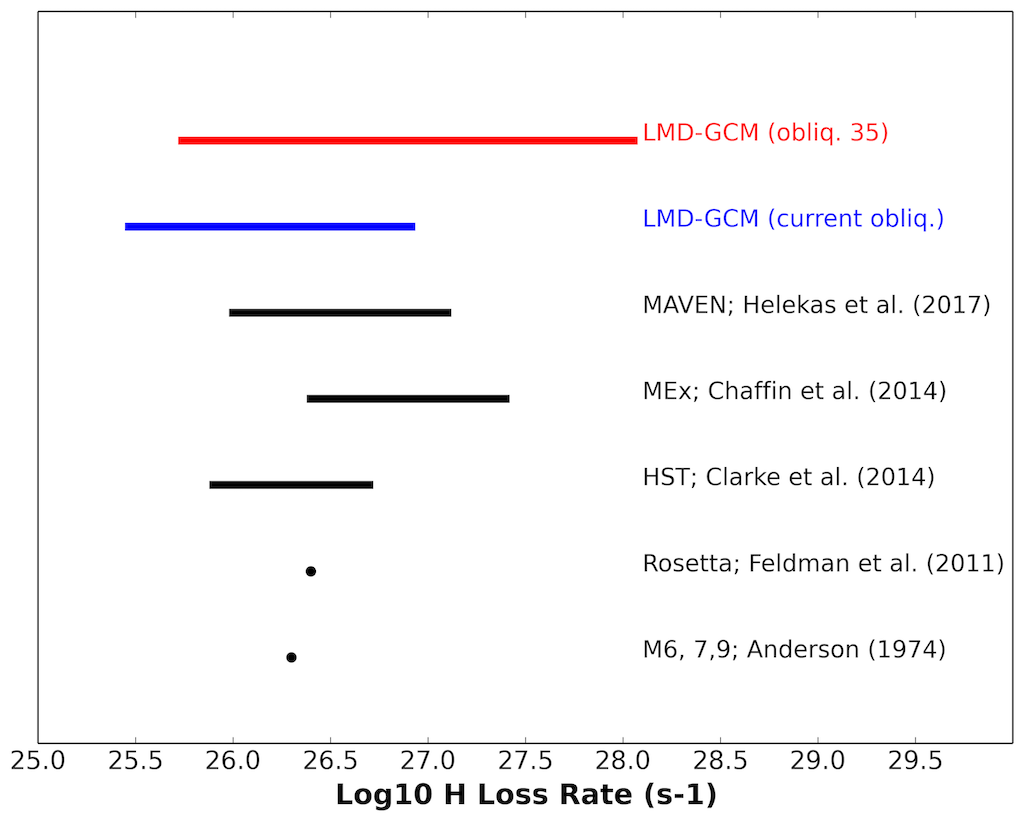On the effect of the orbital parameters of Mars to the H escape and the fate of water in the last millions of years
- 1Instituto de Astrofisica de Andalucia (IAA-CSIC), Granada, Spain (gilli@iaa.es)
- 2Laboratoire de Météorologie Dynamique (LMD-IPSL), CNRS, Paris, France
- 3LATMOS, CNRS, Paris, France
Introduction
The climate of Mars during its first billion years is one of the most intriguing questions in our understanding of the Solar System. Mars was not always as dry as it is today, as several geologic and mineralogical observations indicate the evidence for past liquid water: valley networks and lakes are still visible on the surface (Bibring et al. 2004). Loss to space appears to explain why the Mars atmosphere evolved from an early, warmer climate to the cold, dry climate that we see today. Substantial amounts of water could have escaped into the interplanetary medium in the form of atomic hydrogen H (Jakoski et al. 2018) Furthermore, recent observations indicate that the amount of exosphere hydrogen at Mars has important seasonal variations, with significant increases of both the water abundance in the mesosphere and the H escape rate during dust storms (Chaffin et al. 2004, Clarke e al. 2004).
By analysing observations by SPICAM on board Mars Express and simulations with the LMD Mars General Circulation Model (LMD-MGCM), (Chaufray et al. 2021) suggested that episodic dust storm and associated enhancement at high altitude near the perihelion, averaged over one Martian year or longer period, are a major factor in the H escape estimates. Nevertheless, the accumulated water lost for 4 billion years at the estimated rate is much lower than the amount of water needed to form the flow channels observed on Mars. Both the dust content and the water content of the atmosphere are expected to vary with the obliquity of the planet, thus, the loss rate is definitely not expected to have been constant with time and may vary significantly during Martian history.
Theoretical studies show that in the past 250 Myrs Mars's axis inclination covered a large range of variations, between 0 and 66º, with a mean obliquity of about 35º (Laskar et al. 2004). This variation may have induced significant modifications in fundamental aspects of the Martian climate, mainly due to the differences in the distribution of the insolation, such as the CO2 cycle (and thus the surface pressure), the dust and water cycle, or the global circulation (Forget et al. 2017)
Preliminary results: H escape during higher obliquity periods
In this work we use an improved version of the ground-to-exosphere Mars General Circulation Model (MGCM) developed at the Laboratoire de Meteorologie Dynamique (LMD) (see Gonzalez-Galindo et al. EPSC 2022, this session) to provide an estimation of the variation of water escape in past epochs characterized by different orbital parameters. Our simulations with the LMD-MGCM show that, when the martian obliquity was higher (e.g. 35º) than current values, the escape rate could have increased up to one order of magnitude (1028 atoms/s), especially during dust storm seasons (see Figure 1). This indicates that a significant H loss could have taken in the past, producing the evaporation of the large reservoir of liquid water potentially present on the surface of Mars in the past million of years.

Figure 1: Estimated H loss rate (atoms/s) from observations made from different spacecraft, together with simulated H loss rate (min/max values over 1 Martian Year) for comparison. (Adapted from Jakoski et al. 2018).
Acknowledgments: GG and FGG are funded by the Spanish Ministerio de Ciencia, Innovación y Universidades, the Agencia Estatal de Investigación and EC FEDER funds under project RTI2018100920JI00.The IAA team acknowledges financial support from the State Agency for Research of the Spanish MCIU through the Center of Excellence Severo Ochoa" award to the Instituto de Astrofísica de Andalucía (SEV20170709)
References:
[1] Bibring et al. (2004). “Perennial water ice identified in the south polar cap of Mars.”, 428(6983):627–630, Nature
[2] Jakoski et al. (2018) “Loss of the Martian atmosphere to space: Present-day
loss rates determined from MAVEN observations and integrated loss through time”, 315:146–157, Icarus
[3] Chaffin et al.(2014) ,“Unexpected variability of Martian hydrogen escape”, 41(2):314–320 GRL
[4] Clarke et al. (2014), “A rapid decrease of the hydrogen corona of Mars”, 41(22):8013–802, GRL
[5] Chaufray et al. (2021), “Study of the hydrogen escape rate at Mars dur-
ing martian years 28 and 29 from comparisons between SPICAM/MEx observations and GCM-LMD simulations”, 353:113498, Icarus
[6] Laskar et al (2004), “Long term evolution and chaotic diffusion of the insolation quantities of mars,”, 170(2):343–364 Icarus
[7] Forget et al. (2017), “Recent climate Variations”, ACM 2017, p. 464–496. 2017.
How to cite: Gilli, G., Gonzalez-Galindo, F., Forget, F., Millour, E., Naar, J., and Chaufray, J.-Y.: On the effect of the orbital parameters of Mars to the H escape and the fate of water in the last millions of years, Europlanet Science Congress 2022, Granada, Spain, 18–23 Sep 2022, EPSC2022-578, https://doi.org/10.5194/epsc2022-578, 2022.

